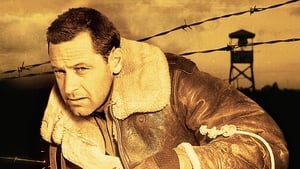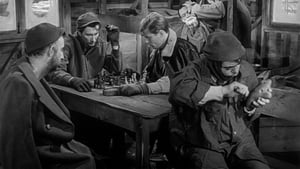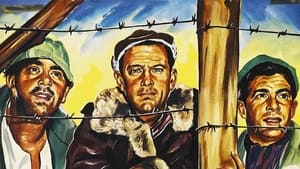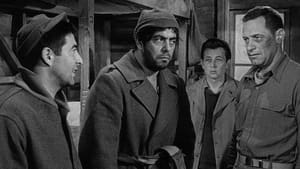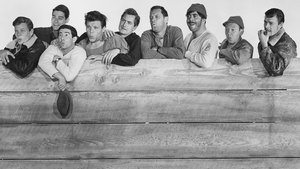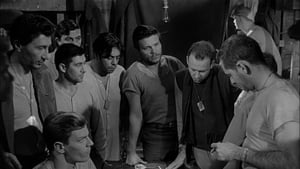Video Sources 0 Views
- Watch trailer
- Stalag 17 1953 Colorized

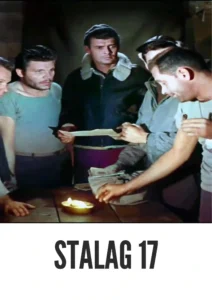
Synopsis
Table of Contents
Toggle
Delve into the harsh realities of a World War II prisoner-of-war camp with Stalag 17, a compelling war drama from 1953, now beautifully colorized for a powerfully immersive viewing experience. Starring William Holden and directed by Billy Wilder, this film delivers a suspenseful and often darkly humorous look at the lives of American airmen held captive in a German POW camp. Perfect for war movie buffs and those seeking a gripping story of survival and suspicion, this HD download brings a fresh perspective to a celebrated cinematic achievement.
Stalag 17 unfolds within the confines of a German prisoner-of-war camp, where a group of American airmen are held captive. The story kicks off when two prisoners are killed while attempting to escape, leading the remaining men to suspect that one of their own is a German informant.
Amidst the grim realities of camp life, suspicion falls on J.J. Sefton (William Holden), a cynical and opportunistic prisoner who seems more interested in looking out for himself than helping his fellow inmates. As the prisoners grapple with hunger, boredom, and the constant threat of discovery, they try to uncover the traitor in their midst. Sefton, despite being the prime suspect, conducts his own investigation, navigating a web of deceit and danger to reveal the true informant. The film balances suspense with dark humor, showcasing the resilience and camaraderie of the prisoners as they struggle to survive. Ultimately, Stalag 17 is a gripping and thought-provoking exploration of loyalty, betrayal, and the human spirit in the face of adversity.
Stalag 17 boasts a stellar cast of actors who bring these complex characters to life:
-
William Holden as Sergeant J.J. Sefton
-
Don Taylor as Lieutenant Dunbar
-
Otto Preminger as Oberst von Scherbach
-
Robert Strauss as Stanislaus “Animal” Kasava
-
Harvey Lembeck as Harry Shapiro
Stalag 17 is a war drama with elements of suspense, dark humor, and even a touch of film noir. Its setting in a prisoner-of-war camp provides a unique backdrop for exploring themes of survival, suspicion, and the resilience of the human spirit.
Released in 1953, Stalag 17 arrived during a period when Hollywood was beginning to explore the complexities and psychological toll of World War II. Unlike earlier war films that often presented a more straightforwardly heroic view of combat, Stalag 17 offered a more nuanced and cynical perspective. The film reflects a growing awareness of the moral ambiguities and personal struggles faced by soldiers during wartime. Billy Wilder’s direction brought a distinctive blend of realism and dark humor to the story, challenging conventional portrayals of war and heroism. Stalag 17 became a critical and commercial success, solidifying Wilder’s reputation as a visionary filmmaker and influencing subsequent war films.
This colorized version of Stalag 17 has been meticulously enhanced using advanced digital techniques, enriching the visual experience while preserving the film’s original atmosphere of tension and confinement. The colorization process involved a careful analysis of the original black and white footage, with particular attention paid to recreating the drab, muted tones of the prisoner-of-war camp. The specific tools and software utilized are proprietary, but the techniques employed included sophisticated algorithms for color palette selection and image enhancement. This painstaking process breathes new life into the characters and settings, making the story even more impactful for contemporary audiences. While the practice of colorizing classic films can be debated, it serves to introduce these important works to a broader audience, ensuring their continued relevance and appreciation for future generations.
-
: Billy Wilder
-
: Billy Wilder, Edwin Blum
-
: the play by Donald Bevan and Edmund Trzcinski
-
: Ernest Laszlo
-
: George Tomasini
-
: Paramount Pictures
-
: Paramount Pictures
-
: 120 minutes
-
: MP4
-
: HD (1080p)
-
: Compatible with most devices, including smartphones, tablets, computers, and smart TVs.
Stalag 17 (1953) is widely regarded as a classic of post-war American cinema, earning critical acclaim and commercial success upon its release. William Holden’s performance as Sergeant J.J. Sefton won him the Academy Award for Best Actor, and the film was nominated for Best Director and Best Supporting Actor (Robert Strauss). Critics praised the film’s sharp dialogue, suspenseful plot, and realistic portrayal of life in a prisoner-of-war camp. Stalag 17 remains a powerful and influential film, offering a compelling exploration of human nature under extreme circumstances.
-
: What is Stalag 17 about?
-
A: Stalag 17 is a war drama about a group of American airmen held in a German prisoner-of-war camp who suspect that one of their own is a German informant.
-
-
: Is Stalag 17 (1953) based on a true story?
-
A: Stalag 17 is based on a play by Donald Bevan and Edmund Trzcinski, which was inspired by their own experiences as prisoners of war in Stalag XVIIB in Austria.
-
-
: Is this version of Stalag 17 colorized?
-
A: Yes, this version has been professionally colorized to enhance the viewing experience.
-
-
: What makes Stalag 17 interesting for war movie fans?
-
A: Stalag 17 offers a unique and nuanced perspective on the experience of American prisoners of war during World War II, with a blend of suspense, dark humor, and compelling characters.
-
-
: What is the download format?
-
A: The download format is MP4, which is compatible with most devices.
-
-
: What resolution is the download?
-
A: The resolution is HD (1080p), providing a high-quality viewing experience.
-
Watch Stalag 17 Today!
